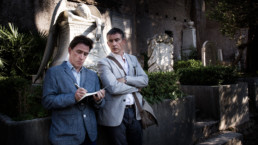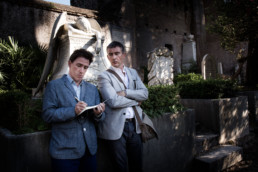Review: ‘The Trip to Italy’
While the formula follows the same strides as its predecessor as a non-stop riff, the film captures a new freshness with even "funnier" comedic bits.
It takes just one scene into The Trip To Italy until “Steve Coogan” receives a call from his best mate “Rob Brydon,” and is surprised to hear that the same publication that planned their previously shared trip abroad intends to once again send them off to eat fine foods and take in rich culture, all chronicled alongside their comically philosophic ramblings and best Michael Caine impersonations; and just like that, we’re plopped in a top-down Mini-Cooper, gliding through the breathtaking hills of the beautiful Italian countryside, back with the British whip-smarts on another jolly jaunt of leisure and laughs.
To give a brief overview, The Trip to Italy effectively serves as the sequel of sorts to the film (and before that, the British TV series, of the same name) that previously featured the real-life British celebrities Steve Coogan and Rob Brydon, playing meta-versions of themselves, who are treated to an all-expenses-paid-for trip abroad in the even more succinctly titled, The Trip. And although the formula here follows the same strides as its predecessor as a non-stop riffing, mostly improvised buddy film-done-BBC (once again, written and directed by Michael Winterbottom), this reviewer found the film to capture a freshness just as unique and worthwhile as its polished predecessor, with its gorgeous camerawork capturing the magisterial landscape along with even more dialed in and “funnier” comedic bits.
Even if you have yet to see the first Trip outing, it won’t be hard at all to jump right into the game of the movie. I admit, I myself, a fan of the first film for its high-meets-low brow package, featuring enough nuance and detail in its impeccably crafted cuisine courses as in its measured and just-narrative-enough storyline, wasn’t sure if a second film could capture the same unique experience that the first one so wonderfully did. I further secretly hoped to see any scene just as funny as Coogan and Brydon’s previous Michael Caine-off (wherein the first film, the two, seated formally at a fine-dining restaurant, proceeded to one-up each other with side-achingly hilarious impersonations of the knighted Englishman throughout the years), which would deem the film just as worthwhile. And how pleasantly satisfied I soon was, for but not at their first seated full-course meal did the two begin to recall their previous Michael Caine-off, and have me falling right back into side-splitting hysterics. Without giving too much away, the pair elevate the charade even higher, by bringing in more of Michael Caine’s contemporaries from his most recently popular blockbuster film.
How pleasantly satisfied I soon was, for but not at (Coogan and Brydon’s) first seated full-course meal did the two begin to recall their previous Michael Caine-off, and have me falling right back into side-splitting hysterics.
With these constant impersonations, audiences will either find the trip taken with these two ever-renewing and rewarding, or the shtick may tend to wear. But Brydon here is in full comedic form, bouncing around from moment to moment like a yippy dog building off of its own excitement of trying to excite Coogan’s more upturned and debonair self. And the chemistry here could not be more perfectly played (having honed the relationship over years of work), and could not reveal a more complementary chemistry. Brydon, whose lesser-known celebrity (to American audiences, at least), is comprised of having an equally disorienting fascination with Lord Byron as with his revolving carousel of celebrity impersonations, including a wheel-house “Hugh Grant” and a newer-worked “Al Pacino.” What’s interesting here, or perhaps at least noticeable, is that in The Trip to Italy, there are a few instances where the same impersonations and comic beats arise that make the audience aware that they had just given their laugh to the same bit in earlier scenes. Perhaps this points to the fact that this sequel had the luxury of knowing what “worked” in the first film, and played those hands in more than multiple turns. In this sense, a small handful of the comic workings feel a bit repetitive, and we wish that the story would move on to the next new location and scene. However, it’s a small price to pay when you realize that the story is probably all strung together by Coogan and Brydon’s improvisational dialogue.
There is however, amidst all of the readily funny, off-the-cuff joke-making, a focused narrative that the characters follow throughout. And what works in this film, much like in the first, is that both characters, amidst the “funniness” they create amongst themselves, are each dealing with independently personal matters that they are forced to acknowledge and confront, even during their vacations away from their real worlds. Here, Coogan’s “Coogan” is seen a bit more weighed down by the time spent apart from his now high school-aged son Joe (Timothy Leach), living mostly with his divorced wife, and we often circle back to Coogan trying to reconnect with him over the phone and Skype. Meanwhile, and played with even richer of revealing affairs, Brydon’s “Brydon” is seen confronting his own insecurities, as during one stop on the trip he puts himself on tape to audition for an “American Michael Mann movie” for the part of an Italian mob’s banker, but can’t escape falling back on his best Pacino impersonation to read the lines. Here, and in a stolen scene where he calls his wife from the hotel room in full Hugh Grant-mode, is soon enough left to trail off into defeated mock-self conversation with the bumbling Brit’s voice after his busy-at-home wife resigns herself off of the phone. Moments like these provide the film well enough dramatic earnings that provide a nice counter-balance to the overall lighthearted nature and give a grounded baseline for the rest of the movie’s many offshoots to springboard from.
And of course, the film will delight and inspire audiences of all kinds simply with its many locations that it captures, including Liguria, Tuscany, Rome, Amalfi, and ending up in Capri. The stunning Italian countryside, moving to the breathtaking coast, where Coogan and Brydon day-trip by sailboat, and all around, are shot in truly inspired fashion, in no small part from the work of cinematographer James Clarke, who manages the none-small feat of providing an aesthetically beautiful backdrop to frame the characters’ story in as well as fawning audience awe over. The details in the locations and delicacies abound in every cultural landmark and in every dinner dish, serving as such visual treats that when the story takes its momentary dips in inspiration, there still stands more than enough sensory satisfaction to enjoy.
The Trip to Italy is that rare type of movie whose largely improvisational filmmaking style is grounded in such weighted thematic and visual impress, that to watch the movie unfurl feels constantly new and fun. Most impressively, even in its grandly impossible and beautiful world, it impressively manages to capture a sense of real life, most all thanks given to its talented leading actors’ who create a third entity between them, a special instance from the combination of their greatly realized comic personas. One of my favorite scenes was nearer to the end, when Coogan and Brydon, again, sitting across from each other sharing a meal over a gorgeous Italian coastal line, got into a bit about Coogan’s “celebrity” (or lack-thereof)- where Brydon built up to such funny momentum that even Coogan- whose movie-long poker face stood resilient amidst his counterpart’s manic-delivery- finally broke, and couldn’t help but wholeheartedly laugh at what was another well-earned and hilarious scene. Even if you weren’t there for the first trip around, this is definitely one that I’d recommend tagging along to.
https://www.youtube.com/watch?v=55OtglvtXuI
Ryan Rojas
Ryan is the editorial manager of Cinemacy, which he co-runs with his older sister, Morgan. Ryan is a member of the Hollywood Critics Association. Ryan's favorite films include 2001: A Space Odyssey, The Social Network, and The Master.


